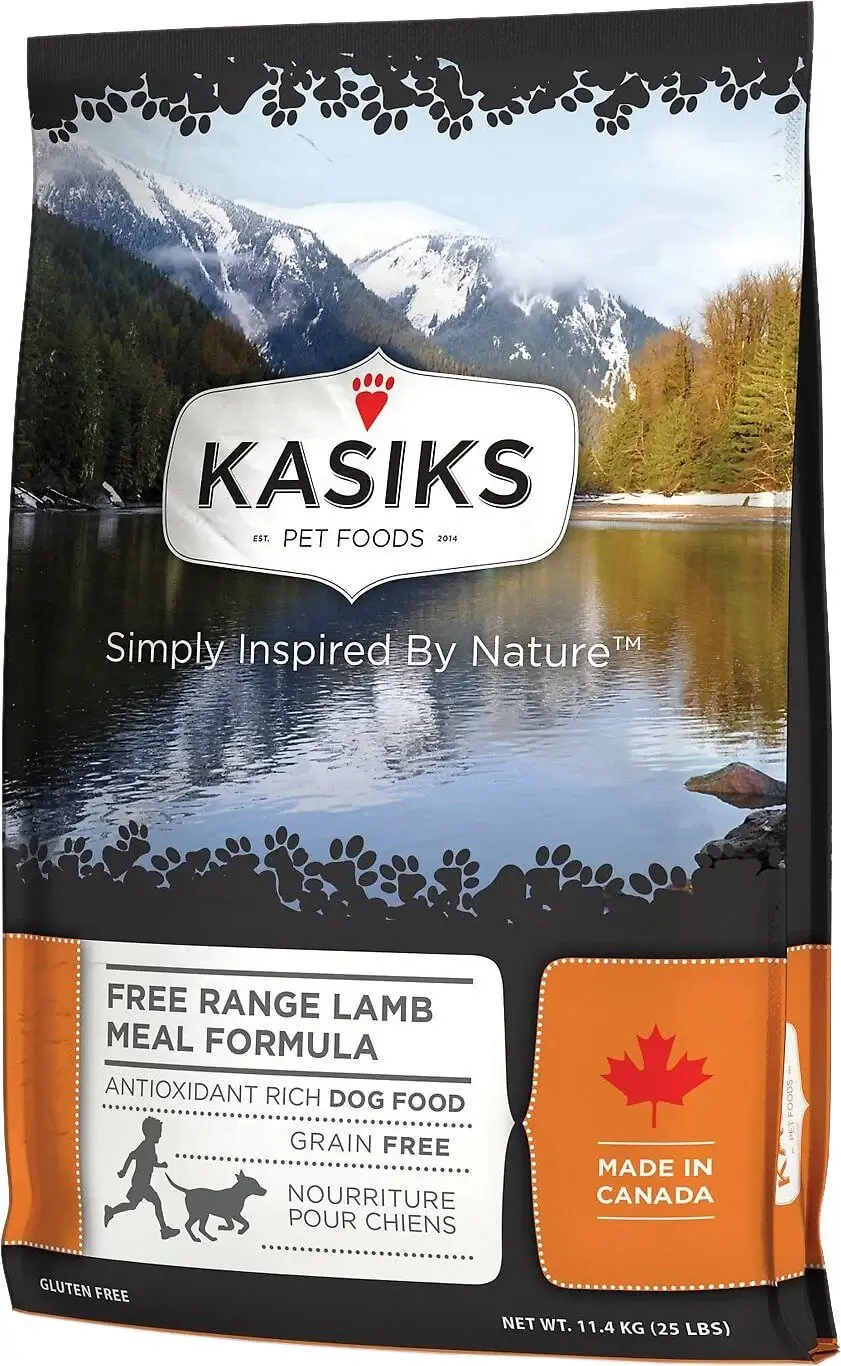Kasiks Dog Food Review (Dry)

DogFoodAdvisor is reader supported See how
All reviews are 100% impartial but if you buy using links on this page, we may earn a referral fee.
Review of Kasiks Dog Food
Kasiks Dog Food receives the Advisor’s second-highest tier rating of 4 stars.
The Kasiks product line includes the 3 dry dog foods listed below.
Each recipe includes its AAFCO nutrient profile when available… Growth (puppy), Maintenance (adult), All Life Stages, Supplemental or Unspecified.
| Product | Rating | AAFCO |
|---|---|---|
| Kasiks Wild Pacific Ocean Fish Meal | 4 | A |
| Kasiks Free Range Lamb Meal | 4 | A |
| Kasiks Free Run Chicken Meal | 4 | A |
Recipe and Label Analysis
Kasiks Free Range Lamb Meal was selected to represent the other products in the line for detailed recipe and nutrient analysis.
Label and nutrient data below are calculated using dry matter basis.
Kasiks Free Range Lamb Meal
Estimated Dry Matter Nutrient Content
Protein
Fat
CarbsCarbohydrates
Lamb meal, chickpeas, lentils, peas, tomato pomace, salt, potassium chloride, DL–methionine, minerals, (zinc proteinate, iron proteinate), calcium carbonate, chicken fat (preserved with mixed tocopherols), (manganese proteinate, copper proteinate, selenium yeast, calcium iodate), vitamins, (vitamin E supplement, niacin, thiamine mononitrate, D-pantothenic acid, vitamin A supplement, riboflavin, pyridoxine hydrochloride, biotin, vitamin B12 supplement, vitamin D3 supplement, folic acid), choline chloride, calcium propionate (a preservative), yeast extract, taurine, blueberries, raspberries, cranberries, rosemary extract, coconut, kale
Fiber (estimated dry matter content) = 8%
Red denotes any controversial items
| Estimated Nutrient Content | |||
|---|---|---|---|
| Method | Protein | Fat | Carbs |
| Guaranteed Analysis | 28% | 12% | NA |
| Dry Matter Basis | 31% | 13% | 48% |
| Calorie Weighted Basis | 28% | 29% | 43% |
Ingredient Analysis
The first ingredient in this dog food is lamb meal. Lamb meal is considered a meat concentrate and contains nearly 300% more protein than fresh lamb.
The second ingredient is dried chickpeas. Chickpeas (also known as garbanzo beans) are a good source of carbohydrates. Plus they’re naturally rich in dietary fiber.
However, dried chickpeas contain about 27% protein, a factor that must be considered when judging the meat content of this dog food.
The third ingredient is lentils. Lentils are a quality source of carbohydrates. Plus (like all legumes) they’re rich in natural fiber.
However, lentils contain about 25% protein, a factor that must be considered when judging the actual meat content of this dog food.
The fourth ingredient is peas. Peas are a quality source of carbohydrates. And like all legumes, they’re rich in natural fiber.
However, peas contain about 25% protein, a factor that must be considered when judging the meat content of this dog food.
The fifth ingredient is tomato pomace, which is a controversial ingredient, a by-product remaining after processing tomatoes into juice, soup and ketchup.
Many praise tomato pomace for its high fiber and nutrient content, while others scorn it as an inexpensive pet food filler.
Just the same, there’s probably not enough tomato pomace here to make much of a difference.
The sixth ingredient is salt (also known as sodium chloride). Salt is a common additive in many dog foods. That’s because sodium is a necessary mineral for all animals — including humans.
However, since the actual amount of salt added to this recipe isn’t disclosed on the list of ingredients, it’s impossible to judge the nutritional value of this item.
The seventh ingredient is potassium chloride, a nutritional supplement sometimes used as a replacement for the sodium found in table salt.
From here, the list goes on to include a number of other items.
But to be realistic, ingredients located this far down the list (other than nutritional supplements) are not likely to affect the overall rating of this Kasiks product.
With 5 notable exceptions…
First, yeast extract is the common name for a broad group of products made by removing the cell wall from the yeast organism.
A significant number of these ingredients are added as specialized nutritional supplements while others are used as flavor enhancers.
However, the glutamic acid (and its chemical cousin, monosodium glutamate, or MSG) found in a minority of yeast extracts can be controversial.
That’s because even though the Food and Drug Administration designated these food additives to be safe decades ago, the agency continues to receive reports of adverse effects.
So, detractors still object to the use of yeast extract and other glutamic acid derivatives and blame them for everything from Alzheimer’s (in humans) to obesity.
In any case, since the label reveals little about the actual type of yeast extract included in any recipe, it’s impossible for us to judge the quality of this ingredient.
Next, we note the use of coconut. Depending upon the quality of the raw material, coconut is rich in medium chain fatty acids.
Medium-chain triglycerides have been shown to improve cognitive function in older dogs.1
Because of its proven safety2 as well as its potential to help in the treatment of canine cognitive dysfunction syndrome (CDS) and chronic skin disorders, MCT can be considered a positive addition to this recipe.
In addition, this food contains chelated minerals, minerals that have been chemically attached to protein. This makes them easier to absorb. Chelated minerals are usually found in better dog foods.
Next, we note the use of taurine, an important amino acid associated with the healthy function of heart muscle. Although taurine is not typically considered essential in canines, some dogs have been shown to be deficient in this critical nutrient.
Since taurine deficiency appears to be more common in pets consuming grain-free diets, we view its presence in this recipe as a positive addition.
And lastly, this recipe includes selenium yeast. Unlike the more common inorganic form of selenium (sodium selenite), this natural yeast supplement is considered a safer anti-cancer alternative.
Nutrient Analysis
Based on its ingredients alone, Kasiks Dog Food looks like an above-average dry product.
The dashboard displays a dry matter protein reading of 31%, a fat level of 13% and estimated carbohydrates of about 48%.
As a group, the brand features an average protein content of 33% and a mean fat level of 13%. Together, these figures suggest a carbohydrate content of 46% for the overall product line.
And a fat-to-protein ratio of about 41%.
Which means this FirstMate product line contains…
Above-average protein. Below-average fat. And below-average carbs when compared to a typical dry dog food.
When you consider the protein-boosting effect of the chickpeas, lentils and peas, this looks like the profile of a kibble containing just a moderate amount of meat.
Our Rating of Kasiks Dog Food
Kasiks is a grain-free dry dog food using a moderate amount of named meat meals as its primary source of animal protein, thus earning the brand 4 stars.
Highly recommended.
However, it’s unfortunate the company chose to include so much plant-based protein in its recipe. Otherwise, we would have been compelled to award this product a higher rating.
FirstMate Dog Food Recall History
The following automated list (if present) includes all dog food recalls since 2009 related to FirstMate.
No recalls noted.
You can view a complete list of all dog food recalls since 2009 here.
Get Free Recall Alerts
Get free dog food recall alerts sent to you by email. Subscribe to The Advisor’s recall notification list.
More FirstMate Brand Dog Food Reviews
The following FirstMate dog food reviews are also posted on this website:
- FirstMate 50/50 Dog Food Review (Canned)
- FirstMate Dog Food Review (Dry)
- FirstMate Grain-Free Dog Food Review (Dry)
- FirstMate Limited Ingredient Dog Food Review (Canned)
- Kasiks Dog Food Review (Canned)
- Skoki Dog Food Review (Dry)
Compare This Dog Food
How does this brand compare with The Dog Food Advisor's most recommended brands?
Sources
A Final Word
The Dog Food Advisor does not accept money, gifts, samples or other incentives in exchange for special consideration in preparing our reviews.
However, we do receive a referral fee from online retailers (like Chewy or Amazon) and from sellers of perishable pet food when readers click over to their websites from ours. This helps cover the cost of operation of our free blog. Thanks for your support.
For more information, please visit our Disclaimer and Disclosure page.







